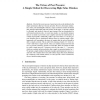Free Online Productivity Tools
i2Speak
i2Symbol
i2OCR
iTex2Img
iWeb2Print
iWeb2Shot
i2Type
iPdf2Split
iPdf2Merge
i2Bopomofo
i2Arabic
i2Style
i2Image
i2PDF
iLatex2Rtf
Sci2ools
CAIP
2015
Springer
2015
Springer
The Virtues of Peer Pressure: A Simple Method for Discovering High-Value Mistakes
Much of the recent success of neural networks can be attributed to the deeper architectures that have become prevalent. However, the deeper architectures often yield unintelligible solutions, require enormous amounts of labeled data, and still remain brittle and easily broken. In this paper, we present a method to efficiently and intuitively discover input instances that are misclassified by well-trained neural networks. As in previous studies, we can identify instances that are so similar to previously seen examples such that the transformation is visually imperceptible. Additionally, unlike in previous studies, we can also generate mistakes that are significantly different from any training sample, while, importantly, still remaining in the space of samples that the network should be able to classify correctly. This is achieved by training a basket of N “peer networks” rather than a single network. These are similarly trained networks that serve to provide consistency pressure...
| Added | 17 Apr 2016 |
| Updated | 17 Apr 2016 |
| Type | Journal |
| Year | 2015 |
| Where | CAIP |
| Authors | Shumeet Baluja, Michele Covell, Rahul Sukthankar |
Comments (0)

